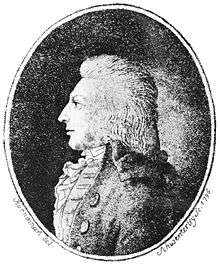Christiaan Hendrik Persoon
Christiaan Hendrik Persoon (1 February 1761 – 16 November 1836) was a German mycologist who made additions to Linnaeus' mushroom taxonomy.
Christiaan Hendrik Persoon | |
|---|---|
 | |
| Born | 1 February 1761 |
| Died | 16 November 1836 (aged 75) Paris, France |
| Known for | Establishing starting points for fungal taxonomy |
| Scientific career | |
| Fields | Mycology, taxonomy |
| Author abbrev. (botany) | Pers. |
Early life
Persoon was born in South Africa at the Cape of Good Hope, the third child of an immigrant Pomeranian father and Dutch mother.[1] His mother died soon after he was born; at the age of thirteen his father (who died a year later) sent him to Europe for his education.
Education
Initially studying theology at Halle, at age 22 (in 1784) Persoon switched to medicine at Leiden and Göttingen. He received a doctorate from the "Kaiserlich-Leopoldinisch-Carolinische Deutsche Akademie der Naturforscher" in 1799.[2]
Later years
He moved to Paris in 1802, where he spent the rest of his life, renting an upper floor of a house in a poor part of town. He was apparently unemployed, unmarried, poverty-stricken and a recluse, although he corresponded with botanists throughout Europe. Because of his financial difficulties, Persoon agreed to donate his herbarium to the House of Orange, in return for an adequate pension for life.[3]
Academic career
The origin of Persoon's botanical interest is unknown. The earliest of his works was Abbildungen der Schwämme (Illustrations of the fungi), published in three parts, in 1790, 1791, and 1793. Between 1805 and 1807, he published two volumes of his Synopsis plantarum, a popular work describing 20,000 species of all types of plants. But his pioneering work was in the fungi, for which he published several works, beginning with the Synopsis methodica fungorum (1801); it is the starting point for nomenclature of the Uredinales, Ustilaginales, and the Gasteromycetes. Persoon described many polypore species; most were from his own collections in central Europe, while several other tropical species were sent to him from collections made by French botanist Charles Gaudichaud-Beaupré during his circumglobal expedition. These latter fungi are among the first tropical polypores ever described.[4] In 1815, Persoon was elected a corresponding member of the Royal Swedish Academy of Sciences.
The genus Persoonia, a variety of small Australian trees and shrubs, was named after him. The title Persoonia is also given to a biannual scientific journal of molecular phylogeny and evolution of fungi, published jointly by the National Herbarium of the Netherlands and the CBS Fungal Biodiversity Centre.[5]
References
- Duane Isely, One hundred and one botanists (Iowa State University Press, 1994), pp. 124–126.
- Chater A.O., Brummitt, R.K. (1966). Subspecies in the works of Christiaan Hendrik Persoon. Taxon 15(4):143-8.
- de Zeeuw, R. (1939). Notes on the life of Persoon. Mycologia 31(3): 369-70.
- Petersen R.H. (1977). Some brief reflections on C.H. Persoon. Kew Bulletin 31(3):695-98.
- Ryvarden, Leif (1973). "Type studies in the Polyporaceae–I. Tropical species described by C. H. Person". Persoonia. 7 (2): 305–312.
- "PERSOONIA - Molecular Phylogeny and Evolution of Fungi". Archived from the original on 24 February 2014.
- IPNI. Pers.
External links
| Wikisource has original works written by or about: Christiaan Hendrik Persoon |